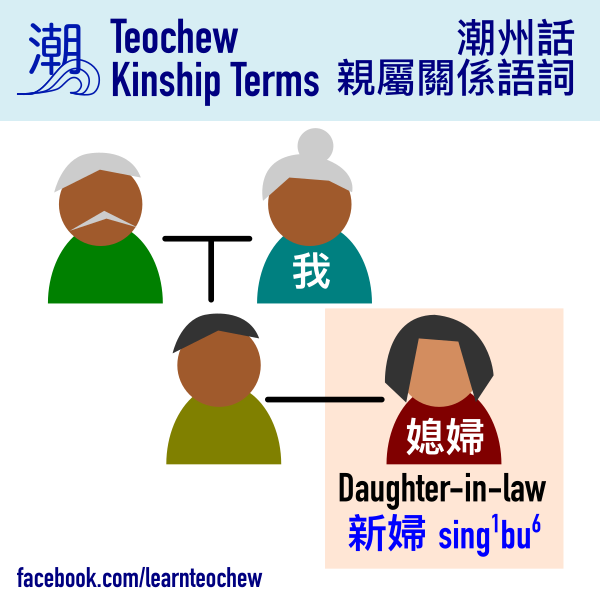Uniquely Teochew/Minnan Kinship Terms (6)
This is the sixth and last in a series of posts on Teochew kinship terms, featuring words used to address relatives that are found in Teochew or other Minnan languages but not in Mandarin.


新婦 sing1bu6 / sim1bu6 • daughter-in-law • 媳婦 xífù
囝婿 gian2sai3 • son-in-law • 女婿 nǚxù
阿郎 a1neng5 • son-in-law • 女婿 nǚxù
新婦 sing1bu6 is also pronounced sim1bu6, where the -ng sound is changed to -m because it is followed by a b- sound, making it easier to pronounce. 新婦 is also a term for “bride” in literary Chinese, but in Teochew, a bride is sing1niê5 新娘.
There are two terms for son-in-law, either 囝婿 gian2sai3, similar to other Min languages, or 阿郎 a1neng5, which seems to be unique to Teochew. It is interesting to observe that the Hakka word for son-in-law is 婿郎 sê4long2. Maybe Teochew and Hakka have had some influence on each other, but if so, who borrowed from whom?
Previous posts
- a1ai5 阿嬡 “mother”
- a1gim6 阿妗 “mother’s brother’s wife”, a1m2 阿姆 “father’s elder brother’s wife”
- bhou2 𡚸 “wife”, ang1 翁 “husband”
- zao6sung1 走孫 “brother’s daughter”, dao1sung1 逗孫 “brother’s son”, sung1 孫 “grandson”, sung1neng2 孫女 “granddaughter”
- da1gê1 大家 “husband’s mother”, da1guan1 大官 “husband’s father”, diên1m2 丈姆 “wife’s mother”, diên1nang5 丈人 “wife’s father”
Posted on 2021-02-09 00:00:00 +0000